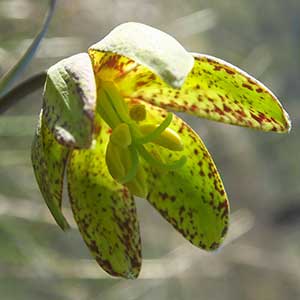Fritillaria glauca
Fritillaria striata
Siskiyou fritillaria, Siskiyou fritillary, Siskiyou missionbells
striped abobe lily, striped Adobe-lily, striped Adobe-lily striped Adobe-lily
large 3–9; small 1–9.
large 2–7; small 0–1.
0.8–2 dm.
2.5–3.8 dm.
2–4, alternate, 3.5–9 cm;
blade lanceolate-oblong, sickle-shaped, glaucous.
3–10, alternate, 6–7 cm;
blade oblong-ovate, ± glaucous.
nodding;
tepals purplish or greenish marked with yellow, lanceolate-oblong, 1.5–2.5 cm, apex not recurved;
nectaries green with maroon dots, broadly lanceolate, less than 1/2 tepal length;
style obviously branched for 1/2 its length, branches longer than 1.5 mm.
nodding, fragrant;
tepals white to pink, often striped red, oblanceolate, 2–3.5 cm, apex acute to apiculate, usually recurved;
nectaries at base of tepals, green, outlined with lavender, linear;
style barely branched, branches shorter than 1.5 mm.
broadly winged.
angled.
= 24.
= 24.
Fritillaria glauca
Fritillaria striata
Of conservation concern.
Fritillaria striata is considered rare and endangered in California, the greatest threat at present being loss of habitat due to cattle grazing.
(Discussion copyrighted by Flora of North America; reprinted with permission.)


